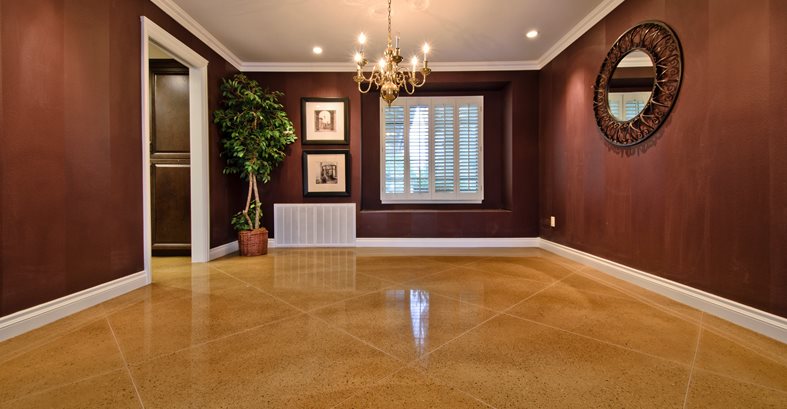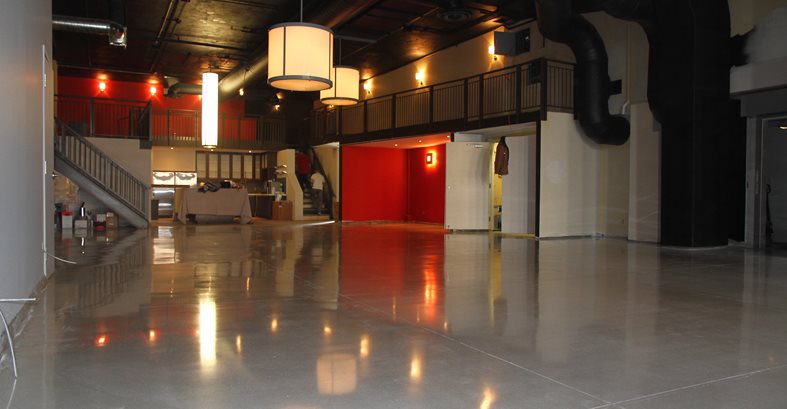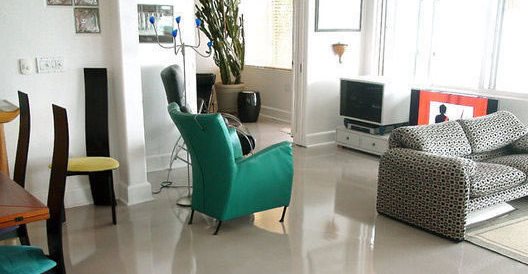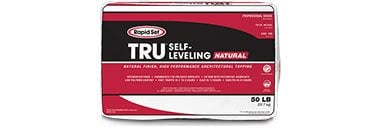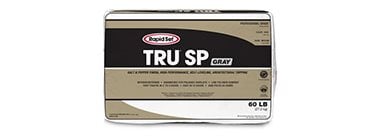INSTALLATION CONSIDERATIONS
Installing a polished overlay requires a different level of expertise than when simply polishing an existing concrete floor. Preparing the floor for the overlay is often the most time-consuming aspect of the process, especially if existing floor coverings must be removed and the underlying floor needs to be reprofiled. Semakov often uses a 10-inch sandblaster and industrial floor grinder to remove residual tile mastic and unsound concrete and leave behind a roughened surface profile.
Placing the overlay itself can also be tricky. It’s not for the faint of heart or those inexperienced with the process, according to Johnson. “Timing is critical on so many parts of this process, such as getting the mix on the floor, seeding the mix at the right time, sawcutting [if desired], and finally polishing the floor and applying dyes and the densifier,” he explains.
Zilian agrees, and says that polishing a concrete overlay requires more coordination of efforts and attention to detail than polishing a conventional concrete slab, so it’s important to be ready for any contingency. “Timing is everything,” he says. “We use lots of manpower and two or three mixing stations to make sure a fresh batch is continuously being delivered to the pour line. We also have a high degree of expertise behind the gauge rake and smoother.”
Once the overlay is down, however, the polishing process is fairly straightforward and can be accomplished with standard concrete polishing equipment. “For overlays, we use the same method as when polishing normal concrete, the same diamond tooling,” says Semakov.
Zilian advises contractors to always use a planetary grinder when polishing concrete overlays and begin polishing no later than 24 hours after overlay placement.
GOING BEYOND BASIC POLISHED CONCRETE
Although it takes time and diligence to perfect the installation of polished overlays, it’s worth the effort. “It’s only a five-step process, and it reveals a rich, deep shine,” says Zilian about his company’s method. He also notes that polished overlays offer distinct qualities that can’t be achieved by polishing existing concrete, such as the ability to create a white polished concrete floor and even distribution of exposed aggregate.
Semakov says that his clients are looking for flooring options beyond basic polished concrete. “At first, our company undertook straightforward projects, like polishing concrete floors for IKEA, which required only diamond polishing and densification. As the market has matured over the years and the industry has gained more experience, the demand has grown for more complicated and aesthetically appealing solutions, including the installation of polished microtoppings as well as the use of dyes, water-based colors, and various lithium and water-based coatings,” he says.
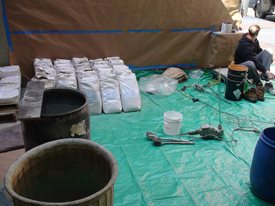
An organized mix station.
TIPS FOR POLISHING CONCRETE OVERLAYS
Polishing a concrete overlay requires more coordination of efforts and attention to detail than polishing a conventional concrete slab. Here are some tips from concrete polishing specialist Tom Zilian of Madstone Concrete, Barrington, R.I., on how to polish cement-based overlays successfully.
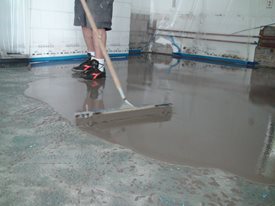
Apply the overlay evenly.
Placing the overlay
- For polishing, you need a very flat floor, free from ripples and smoothing marks, says Zilian, who uses a self-leveling polishable overlay system from Duraamen Engineered Products on his projects.
- Be ready for any contingency that may occur while the pour is in progress by keeping an organized mix station and plenty of backup tools and staff on hand. “Timing is everything,” says Zilian. “We use lots of manpower and two or three mixing stations to make sure a fresh batch is continuously being delivered to the pour line. We also have a high degree of expertise behind the gauge rake and smoother.”
- If you want to seed the surface with glass or other aggregates, wait no longer than 10 minutes after the overlay has been smoothed.

Protect adjacent surfaces.
The polishing process
- Always use a planetary grinder when polishing concrete overlays, and begin polishing no later than 24 hours after overlay placement.
- Use metal-bond diamond tooling for the initial grinding and honing stages (80 grit, then 100 grit). “We make sure we grind deep enough to cut past the air voids around the aggregates if we have seeded them into the overlay at the time of pouring. It is very important to keep the machines steady and watch your pull backs. We keep our rpms a little higher when grinding overlays,” says Zilian.
- Apply a densifier. Zilian prefers to use a colloidal silica-based densifier for his polished overlay projects (such as Duraamen’s Hermetix), because its extremely fine particle size seems to yield better results than traditional sodium- or potassium-based densifiers. When applying a densifier to concrete overlays, Zilian recommends using twice the spread rate as conventional concrete because of their porosity.
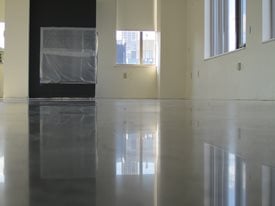
Polish up to 3,000 grit.
Final burnishing
- For the final polishing stages, Zillian uses a series of diamond-impregnated pads (200 grit, 800 grit, and 3,000 grit). “We turn up the rpms as high as the machine will run. We also take the weights off at this point, turning our planetary grinder into a burnisher,” he says.
- Before burnishing, apply a floor conditioner to help protect the floor and enhance the shine. “We have one installer use a pump sprayer to apply the floor finish and another to smooth it out. Within minutes we can be high-speed burnishing.”
Maintaining polished overlays
As a maintenance regimen for polished overlays, Zilian recommends daily vacuuming to remove abrasive particles, along with periodic mopping with a neutral or slightly PH detergent to keep up the shine. He also recommends high-speed burnishing with a 3,000-grit diamond-impregnated pad once a year to revitalize the shine.
Related articlesRead more about polished overlay projects installed by these contractors:
Polishable Overlay Trends: Excerpt from Concrete Overlays Today
When to Use a Polishable Overlay
Polished Concrete Overlay Offers a Seamless Solution to a Buckled Wood Floor
Polished Concrete Floor Overlay Is Ready for Recreation
Find Products & Manufacturers: Polishable Overlays
